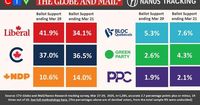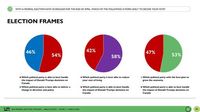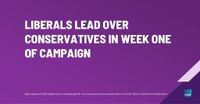As Canada approaches its federal election on April 28, 2025, the political landscape is heating up, with polls indicating a competitive race between the Liberal Party, led by Mark Carney, and the Conservative Party, under Pierre Poilievre. According to an Abacus Data survey released on March 30, 2025, both parties are tied nationally at 39% of the committed vote among all eligible voters. However, when focusing on likely voters—those who say they will definitely cast their ballots—the Liberals gain a slight edge, reaching 41% compared to the Conservatives' 39%.
The New Democratic Party (NDP) continues to lag behind in third place with 11% of the national vote. This polling data marks a significant shift from earlier in the year, as the Liberals have managed to recover from a deficit that had previously favored the Conservatives.
In regional breakdowns, the Liberals and Conservatives are statistically tied in British Columbia, while the Liberals enjoy a three-point lead in Ontario and a commanding 21-point advantage in Atlantic Canada. In Quebec, the Liberals are significantly ahead of the Bloc Québécois by 13 points, showcasing their ability to consolidate the federalist vote and attract soft nationalists.
One of the most notable trends in this election cycle is the shifting demographics of support. Young voters aged 18-30 have increasingly aligned with the Liberals, closing the gap that had previously favored the Conservatives. Additionally, older voters (60+) are showing a growing preference for the Liberals, further complicating the Conservatives' traditional support base.
Despite these gains, the Conservatives maintain a lead among Millennials and Gen X voters, particularly those concerned about the cost of living. Poilievre's focus on affordability issues resonates with these groups, as they navigate the challenges of housing, childcare, and family expenses.
Interestingly, voter enthusiasm appears to be on the rise this election season, with 68% of Canadians stating they are definitely going to vote, a four-point increase from the last survey. Overall, 72% express a high level of interest in the upcoming election. This engagement is particularly strong among older Canadians, with 85% of those aged 60 and over indicating they are very interested.
However, the desire for change appears to be softening. While a majority still prefer a change in government, the percentage of those who strongly desire it has dipped. Notably, 23% of Canadians now express a clear desire to see the Liberals re-elected, a figure that has risen since previous polls.
Leadership perceptions also play a critical role in shaping voter preferences. Carney enjoys a net favorability rating of +11, with 42% of respondents holding positive views of him compared to 31% who view him negatively. This positive perception is bolstered by his reputation as a steady leader during turbulent times, particularly in Atlantic Canada and Ontario, where he garners majority support.
In contrast, Poilievre's favorability has taken a hit, with 45% of respondents expressing negative views of him, resulting in a net rating of -7. His strongest support remains among older Canadians and men, but he struggles significantly in Quebec, where fewer than one in three voters view him positively.
As the election campaign unfolds, the impact of external factors, particularly the influence of U.S. President Donald Trump, looms large. Recent polling indicates that 54% of Canadians believe the election is primarily about managing the challenges posed by Trump's presidency, while 46% see it as a question of changing domestic leadership. When forced to choose between these two frames, affordability issues take precedence, with 58% of respondents prioritizing cost of living over foreign relations.
The Ipsos poll conducted exclusively for Global News also shows a similar trend, with the Liberals leading at 44% among decided voters, up two points from the previous week, while the Conservatives hold steady at 38%. The NDP has seen a slight decline, now sitting at 9%. Carney's leadership has notably improved his standing as the preferred choice for prime minister, with 44% of voters supporting him compared to 33% for Poilievre.
In Quebec, support for the Bloc Québécois remains at 24%, translating to 5% nationally. The Green Party and the People’s Party of Canada have minimal support, with just 2% and 1%, respectively. Eight percent of respondents remain undecided.
The election campaign has also been marked by a recent phone call between Carney and Trump, described as “extremely productive.” This engagement appears to have resonated positively with some voters, with 51.8% stating they are now more likely to vote for Carney as a result.
As we move closer to election day, the focus on key issues such as healthcare, housing, and economic stability remains paramount. In the Ipsos poll, 28% of voters identified healthcare as a top issue, followed by housing (26%) and the economy (23%). The Liberals are viewed as better equipped to handle healthcare and economic issues, while the Conservatives are seen as more capable of addressing housing and tax concerns.
With just weeks remaining until Canadians head to the polls, the dynamics of this election are fluid. The Liberals appear to have regained some momentum under Carney’s leadership, but the Conservatives still hold substantial support in key demographics. Voter turnout and engagement will be critical, as both parties vie for the support of a population that is increasingly engaged and ready to make their voices heard.
The stakes are high, and as the political landscape continues to evolve, it remains to be seen whether the Liberals can maintain their lead or if the Conservatives will reclaim their footing as the election nears.






